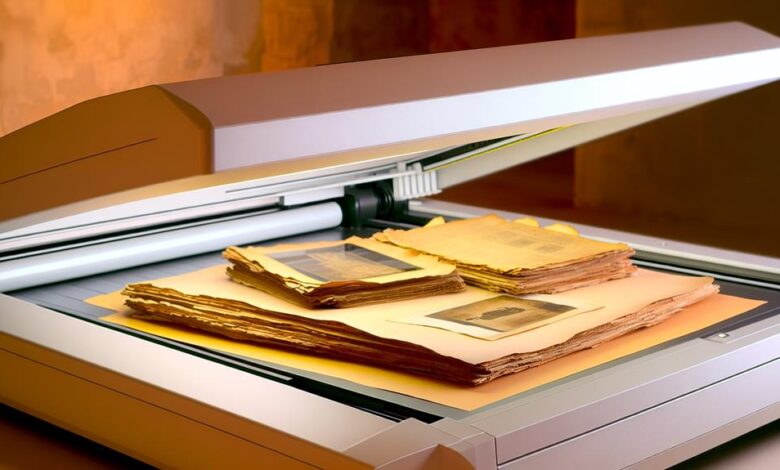FADGI-Compliant Scanners: Ensuring Archival Quality

When you’re looking to preserve valuable collections digitally, FADGI-compliant scanners are essential. These scanners adhere to stringent standards, ensuring that your digital archives maintain the highest quality over time. You’ll find that features like high-resolution sensors and superior color management systems set these devices apart. But what specific benefits do these features provide, and how do they protect against data degradation? Understanding these aspects can significantly impact your choice of equipment for digital preservation. Let’s explore how these scanners make a difference in maintaining the integrity of your collections.
Understanding FADGI Standards
Often, understanding FADGI standards is crucial for anyone involved in digital preservation and archival scanning. These standards, developed by the Federal Agencies Digital Guidelines Initiative, set the benchmark for scanner requirements and image quality, ensuring that your digital reproductions meet rigorous archival criteria.
To comply with FADGI, you must focus on several key scanner requirements. First, your scanner should have a high optical resolution, typically 600 dpi or higher, to capture fine details accurately. It should also support a wide color gamut, ensuring precise color reproduction that aligns with the original materials. Additionally, the scanner’s bit depth, usually 24-bit or higher, is vital for capturing a broad range of tonal values, aiding in the preservation of nuanced details.
Image quality is another critical aspect. FADGI classifies image quality into star ratings (one to four stars), with four stars being the highest. To achieve a higher rating, you need to manage factors like noise reduction, sharpness, and tonal reproduction meticulously.
Regular calibration of your equipment is essential to maintain consistency and adherence to these standards, thereby guaranteeing that your digital archives are both accurate and durable for long-term preservation.
Importance of Archival Quality
Ensuring archival quality in digital preservation is paramount to maintaining the integrity and longevity of your collections. By adhering to rigorous preservation standards, you ensure that the digital surrogates of your physical items remain faithful and usable for future generations. Archival quality isn’t just about high-resolution images; it involves capturing every nuance, color, and detail accurately, thus preserving the original item’s authenticity.
Meeting preservation standards such as those outlined by FADGI (Federal Agencies Digital Guidelines Initiative) is crucial. These standards provide specific guidelines on image quality, color fidelity, and metadata requirements. By following them, you’re not only achieving immediate accuracy but also paving the way for long term access. This means that your digital collections will remain accessible and interpretable as technology evolves.
Archival quality impacts usability and reliability. Poor-quality scans can lead to information loss or misinterpretation, undermining your preservation efforts. Adopting FADGI standards ensures that your digitized materials are resilient against degradation over time, ensuring they meet the stringent criteria necessary for scholarly research, public access, and historical preservation. Thus, prioritizing archival quality is essential for the effective stewardship of your digital assets.
Features of FADGI-Compliant Scanners
When choosing a FADGI-compliant scanner, you’ll find that these devices are engineered to meet the highest standards of digital preservation. They offer superior scanner capabilities that ensure every detail of your archival material is accurately captured. These scanners are equipped with high-resolution sensors, enabling them to produce exceptional image quality. You’ll notice that they can capture fine details, subtle textures, and nuanced color variations, which are critical for maintaining the integrity of historical documents and artworks.
Additionally, FADGI-compliant scanners are designed with advanced color management systems. These systems ensure that the colors in your scanned images match the original material as closely as possible. The dynamic range of these scanners is another standout feature, allowing them to capture both the darkest and lightest areas of an image without losing detail.
You’ll also benefit from their enhanced software capabilities, which include sophisticated algorithms for noise reduction, sharpening, and other image processing tasks.
Benefits for Digital Preservation
You’ll quickly realize that using FADGI-compliant scanners brings substantial benefits for digital preservation. The foremost advantage is long-term preservation. FADGI standards ensure that the image quality of your digital assets remains consistently high, reducing the risk of data degradation over time. High-resolution scans capture fine details, ensuring that every nuance of the original document is preserved.
Additionally, FADGI compliance mandates adherence to stringent metadata standards. This means that throughout the digitization process, comprehensive metadata is embedded within each file.
This metadata includes vital information such as the date of digitization, scanner settings, and file format, which is crucial for maintaining the integrity and authenticity of digital archives.
Choosing the Right Scanner
Selecting the right scanner is critical for achieving FADGI compliance and ensuring the highest quality digital preservation. You need to focus on two primary factors: scanner resolution and scanner speed.
High resolution is essential for capturing fine details in archival materials, which is why you should look for scanners offering at least 600 dpi (dots per inch) for standard documents. For more intricate materials like photographs or fine prints, a scanner capable of 1200 dpi or higher is advisable.
Scanner speed is another crucial consideration. High-speed scanners can process large volumes of documents quickly, which is particularly important for extensive archival projects. However, be cautious: rapid scanning shouldn’t compromise image quality. Ensure that the scanner maintains high resolution even at faster speeds to align with FADGI standards.
You should also consider the scanner’s ability to handle different media types. Flatbed scanners offer versatility for various document sizes and types, while sheet-fed scanners are more suited for loose sheets but may lack in handling delicate or bound materials effectively.
Investing in a scanner that balances high resolution and speed while accommodating your specific archival needs will ensure you achieve FADGI compliance and preserve your materials accurately.
Conclusion
You’ve now seen the critical role FADGI-compliant scanners play in digital preservation. With their ability to capture over 16.7 million colors, these scanners ensure every detail of your archives is preserved with stunning accuracy. By choosing a FADGI-compliant scanner, you’re not just investing in technology; you’re safeguarding history. Keep your collections pristine and accessible for future generations with the unmatched quality and reliability these advanced scanners provide.



